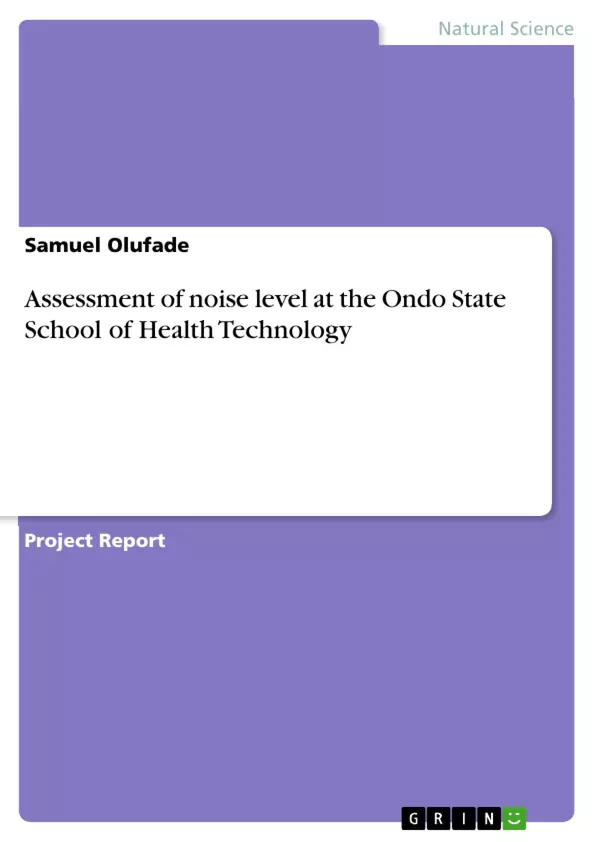This study was carried out in order to investigate the noise level at the Ondo State School of Health Technology, Akure.
Prospective study design was adopted for this study and noise level meter was used to collect data and simple random sampling technique was used. The school was divided into 4 sections which are Academic, commercial, administrative, and residential sections and a sample size of 100 was determined, the retrieved questionnaire were sorted and analyzed using tables and bar charts.
During the course of sampling with noise level meter, it was noted that noise coming from the commercial section was higher than any other section and ranged between 80dB and 89dB which is above the threshold limits man can be exposed to due to the operations carried out in the section. However, at night it was measured to be at lowest level of 49dB based on the close of commercial activities around 7pm daily. In the residential section it was noted that the level of noise produced between the hours of 10am and 1pm was the lowest but from the hour of 2pm upward the noise was at its peak based on the presence of the student in their various lodge ranging between 65dB to 79dB at the academic section the noise level range between 45dB to 60dB which means that the noise levels is low at the section. In the administrative section, the noise produced was between 45dB and 50dB which means that the noise level was at the lowest level for the entire school environment. In the questionnaire people′s knowledge and perception was measured, sorted and analyzed which shows that noise level is high at the ondo state school of Health Technology which should be minimized to enhance a good and conducive environment for learning/teaching.
Inhaltsverzeichnis (Table of Contents)
- ABSRTACT
- CHAPTER ONE.
- 1.0 INTRODUCTION
- 1.1 BACKGROUND OF THE STUDY
- 1.2 STATEMENT OF THE PROBLEMS.
- 1.3 SIGNIFICANCE OF THE STUDY.
- 1.4 OBJECTIVES OF THE STUDY
- 1.5 RESEARCH QUESTIONS.
- 1.6 DEFINITION OF TERMS
- CHAPTER TWO.
- 2.0 LITERATURE REVIEW.
- 2.1 NOISE AND ITS IMPACT ON HEALTH
- 2.2 MAIN SOURCES OF NOISE
- 2.3 NOISE EFFECT ON PUBLIC HEALTH
- 2.4 PRINCIPLE OF NOISE POLLUTION.
- CHAPTER THREE
- 3.0 RESEARCH METHODOLOGY.
- 3.1 DESCRIPTION OF THE STUDY AREA
- 3.2 STUDY DESIGN
- 3.3 SAMPLE SIZE AND SAMPLING PROCEDURE.......
- 3.4 INSTRUMENT FOR DATA COLLECTION
- 3.5 TESTS FOR VALIDITY AND RELIABILITY OF DATA COLLECTION
- 3.6 METHOD OF DATA COLLECTION.
- 3.7 ANALYSIS OF DATA
- CHAPTER FOUR..
- 4.0 RESULT AND DATA ANALYSIS
- CHAPTER FIVE
- 5.0 DISCUSSION OF FINDINGS, CONCLUSION, RECOMMENDATIONS.
- 5.1 DISCUSSION OF FINDINGS..
- 5.2 CONCLUSION
- 5.3 RECOMMENDATION.
- REFERENCES
- 5.5 QUESTIONNAIRE ON THE LEVEL AND EFFECTS OF NOISE ON THE HEALTH OF THE MEMBERS OF ONDO STATE SCHOOL OF HEALTH TECHNOLOGY, AKURE COMMUNITY
Zielsetzung und Themenschwerpunkte (Objectives and Key Themes)
The study aims to investigate the noise levels at the Ondo State School of Health Technology, Akure, and its impact on the health and well-being of students and staff. The study uses a prospective study design and a noise level meter to collect data, focusing on different sections of the school including academic, commercial, administrative, and residential areas. The study also examines the perceptions of students and staff regarding noise levels and their potential effects.
- Noise pollution and its impact on health and well-being
- The effect of noise on learning, communication, and productivity
- The measurement and assessment of noise levels in different environments
- The perception of noise and its impact on individuals
- The role of environmental factors in promoting a conducive learning environment
Zusammenfassung der Kapitel (Chapter Summaries)
- Chapter 1: Introduction - This chapter introduces the concept of noise as an unwanted sound and its impact on human health and well-being. It defines the human environment and discusses the physical, biological, and social aspects. It highlights the importance of a healthy environment and the impact of noise on the physical and mental health of individuals. The chapter emphasizes the adverse effects of noise, including hearing loss, stress, communication interference, and reduced productivity.
- Chapter 2: Literature Review - This chapter provides a detailed review of existing research on noise and its impact on health. It discusses the sources of noise, its effects on public health, and the principles of noise pollution. The chapter explores the adverse effects of noise on various aspects of human health, including auditory and non-auditory effects.
- Chapter 3: Research Methodology - This chapter details the research methodology employed in the study. It includes information about the study area, study design, sample size, sampling procedure, data collection instruments, and data analysis methods. It explains the steps taken to ensure the validity and reliability of the data collected.
- Chapter 4: Result and Data Analysis - This chapter presents the findings of the study based on data collected using a noise level meter and questionnaires. It analyzes the noise levels in different sections of the school, highlighting areas of concern and potential impact on students and staff.
Schlüsselwörter (Keywords)
The study focuses on noise pollution, its impact on human health and well-being, and its effects on a learning environment. Key themes include noise measurement, noise perception, environmental health, and the creation of a conducive learning environment. The research utilizes methods such as prospective study design, noise level meters, questionnaires, and data analysis techniques to investigate noise levels in different sections of the Ondo State School of Health Technology.
- Quote paper
- Samuel Olufade (Author), 2016, Assessment of noise level at the Ondo State School of Health Technology, Munich, GRIN Verlag, https://www.grin.com/document/386150



